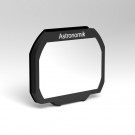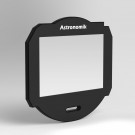- Astronomik Lunar calendar for 2024
The Astronomik calendar of the Lunar phases in 2024 is ready.
- Chistmastime and New Year 2023-2024
We wish you a merry Chirstmastime and a happy and healthy 2024...
- Astronomik Lunar calendar for 2023
The Astronomik calendar of the Lunar phases in 2023 is ready.
- Chistmastime and New Year 2022-2023
We wish you a merry Chirstmastime and a happy and healthy 2023...
- Shipping methods
Shipping as registred good shipment is no longer available
- How to observe planetary nebulae
A very nice introduction to observing planetary nebulas written by Owen Brazell
Astronomik ProPlanet 807 IR-pass filter

Click the image for full resolution
Ideal addition to the Astronomik ProPlanet IR 742 for imaging the moon and planets, with telescopes larger then 10" (250mm) when the seeing is poor.This filter is an ideal complement to the ProPlanet IR 742 for use with converted DSLR cameras, CCD cameras and Webcams. The effects of seeing are distinctly reduced. It is your entry into previously unknown dimensions of photography of the moon and the planets.
The ProPlanet IR 807 only allows infrared light with wavelengths of more than 807 nm to pass. In this wavelength range the effects of seeing are significantly lower than in the visible spectrum of the human eye. This allows much sharper images than are usually obtained from your device and location. Another advantage is that the sky background of advanced dawn is dark and even allows photography of planets and moon at daylight.
Main use
The Astronomik ProPlanet IR 807 cuts off the visible part of the spectrum and allows the light of wavelengths longer then 807nm to pass. Due to this behavior the part of the spectrum that is most sensitive to bad seeing is rejected. This approach does a big improvement to the imaging of planets and the moon. The image is more steady than the image in the visible light.

Jupiter, imaged with L-RGB Filtern (left) and Astronomik ProPlanet 742 (right)

Comparing sharpness in IR-R-G-B at Saturn

Comparing L-RGB versus IR-RGB at Saturn
Other uses
- The Astronomik ProPlanet IR 807 is designed to be an addition to the Astronomik ProPlanet IR 742, if the seeing is extremely bad and a larger telescope is used.
- For most cameras the exposure times doubles, compared to the Astronomik ProPlanet IR 742 or imaging in visible light, if the Astronomik ProPlanet IR 807 is used.
- Darkens the background during twilight.
- Imaging of bright planets, stars and comets by day.
- Imaging of young stars in dust clouds and stellar nurseries.
Alternatives
If the seeing is not so bad or if the telescope is smaller than 10" (250mm) we recommend the use of the Astronomik ProPlanet IR 742.
more information about the photographic Astronomik filters

How to read the chart
The major emission lines of artifical light pollution:
| Hg 435,8nm | Hg 546,1nm | Hg 577,0nm | Hg 578,1nm |
| Na 589,0nm | Na 589,6nm | Na 615,4nm | Na 616,1nm |
The major emission lines of nebulas:
H-β 486,1nm | OIII 495,9nm | OIII 500,7nm | H-α 656,3nm
- The horizontal axis is the Wavelength in Nanometers (nm). 400nm is deep blue, at 520nm the human eye senses green and at 600nm red. At 656nm is the famous "H-Alpha" emission line of hydrogen.
- The transmission in % is plotted on the vertical axis.
- The red line shows the transmission of the filter.
- Visual filters: The grey line in the background shows the relative sensitivity of the human eye at night. The maximum is at ~510nm and drops to longer and shorter wavelengths. You can easily see, that you can´t see anything of the H-alpha line at night (even if you can during daylight!) The sensitivity at 656nm is 0% at night!
- Photographic filters: The grey line in the background shows the sensitivity of a typical CCD sensor.
- The most important artifical emission lines are shown in orange. The artifical light pollution is dominated by see mercury (Hg) and sodium (Na), which are used in nearly all streetlights.
- The most important emission lines from nebulas are shown in green. The most important lines are from ionized Hydrogen (H-alpha and H-beta) and double ionized oyxgen (OIII).
The major emission lines of artifical light pollution:
| Hg 435,8nm | Hg 546,1nm | Hg 577,0nm | Hg 578,1nm |
| Na 589,0nm | Na 589,6nm | Na 615,4nm | Na 616,1nm |
The major emission lines of nebulas:
H-β 486,1nm | OIII 495,9nm | OIII 500,7nm | H-α 656,3nm
Suitability
- Visual observation (dark skies): Unsuitable, the eye is insensitive at this spectrum
- Visual observation (urban skies): Unsuitable, the eye is insensitive at this spectrum
- Film photography: Unsuitable
- CCD photography: Reasonable, for special IR photography (as chlorophyll)
- DSLR photography (original): Unsuitable
- DSLR photography (astro modified): Unsuitable
- DSLR photography (MC modified): Good, for IR daylight photography, longer exposure time
- Webcam / Video (Planets): Very good, rejects problems with seeing, particularly with telescopes larger 250 mm aperture
- Webcam / Video (Deep Sky): Very good, rejects problems with seeing, particularly with telescopes larger 250 mm aperture
Technical Data
- more then 97% transmission for wavelengths of 807nm to 1100nm
- blocking of wavelengths between 350nm and 790nm
- Parfocal with other Astronomik filters
- Glass thickness: 1mm
- Completely resistant against high humidity, scratches and aging effects
- Diffraction limited, the filter will not reduce the optical performance of your telescope!
- Astronomik filters are delivered in a high-quality, long lasting, filter box
- Since 2008 we do ship filters with a completely new design. Any kind of halo or strange reflection is a matter of past
The filter is available in the following sizes
Filter displayed products below by their features
- Size
-
- 1,25" (M28,5) (1)
- 2" (M48) (1)
- T-thread cell (M42x0,75) (1)
- SC-cell (2" / 24TPI) (1)
- Ø27mm (1)
- Ø31mm (1)
- Ø36mm (1)
- Ø42mm (1)
- Ø50mm (1)
- 50x50mm, ungefasst (1)
- EOS APS-C Clip-Filter (1)
- EOS APS-C XT Clip-Filter (1)
- EOS M Clip-Filter (1)
- EOS XL Clip-Filter (1)
- EOS R XL XT Clip-Filter (1)
- Sony alpha Clip-Filter (1)
- Sony alpha XT Clip-Filter (1)
- Nikon XL Clip-Filter (1)
- Nikon Z XL Clip-Filter (1)
- Nikon Z XL XT Clip-Filter (1)
- Pentax K Clip-Filter (1)
- M49 (1)
- M52 (1)
- M55 (1)
- M58 (1)
- M62 (1)
- M67 (1)
- M72 (1)
- M77 (1)
ProPlanet 807 IR-pass filter
-

Astronomik ProPlanet 807 1,25'' (M28,5)
excl. VAT (Non-EU): €49.58 incl. VAT (EU): €59.00 -

Astronomik ProPlanet 807 2'' (M48)
excl. VAT (Non-EU): €100.00 incl. VAT (EU): €119.00 -

Astronomik ProPlanet 807 Clip-Filter EOS APS-C
excl. VAT (Non-EU): €74.79 incl. VAT (EU): €89.00
-

Astronomik ProPlanet 807 XT Clip-Filter EOS APS-C
excl. VAT (Non-EU): €91.60 incl. VAT (EU): €109.00 -

Astronomik ProPlanet 807 Clip-Filter EOS XL
excl. VAT (Non-EU): €108.40 incl. VAT (EU): €129.00 -

Astronomik ProPlanet 807 XT Clip-Filter EOS R XL
excl. VAT (Non-EU): €142.02 incl. VAT (EU): €169.00
-

Astronomik ProPlanet 807 Clip-Filter EOS M
excl. VAT (Non-EU): €79.83 incl. VAT (EU): €95.00 -

Astronomik ProPlanet 807 Clip-Filter Sony alpha 7
excl. VAT (Non-EU): €116.81 incl. VAT (EU): €139.00 -

Astronomik ProPlanet 807 XT Clip-Filter Sony alpha 7
excl. VAT (Non-EU): €142.02 incl. VAT (EU): €169.00
-

Astronomik ProPlanet 807 Clip-Filter Nikon XL
excl. VAT (Non-EU): €108.40 incl. VAT (EU): €129.00 -

Astronomik ProPlanet 807 Clip-Filter Nikon Z XL
excl. VAT (Non-EU): €116.81 incl. VAT (EU): €139.00 -

Astronomik ProPlanet 807 XT Clip-Filter Nikon Z XL
excl. VAT (Non-EU): €142.02 incl. VAT (EU): €169.00
-

Astronomik ProPlanet 807 Clip-Filter Pentax K-1
excl. VAT (Non-EU): €116.81 incl. VAT (EU): €139.00 -

Astronomik ProPlanet 807 T-Mount (M42x0,75)
excl. VAT (Non-EU): €83.19 incl. VAT (EU): €99.00 -

Astronomik ProPlanet 807 SC Rear Cell (2'' / 24TPI)
excl. VAT (Non-EU): €116.81 incl. VAT (EU): €139.00

 Deutsch
Deutsch English
English



